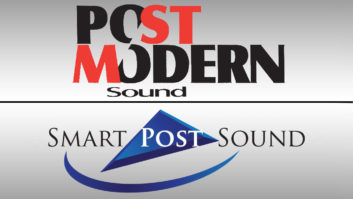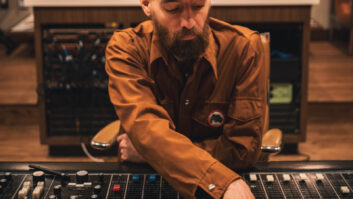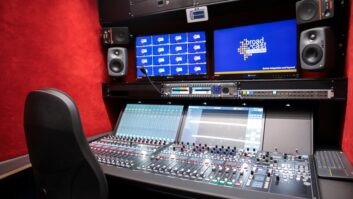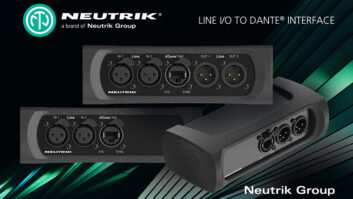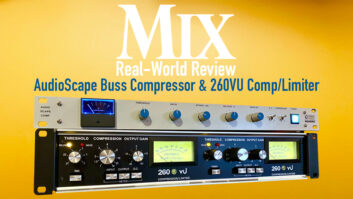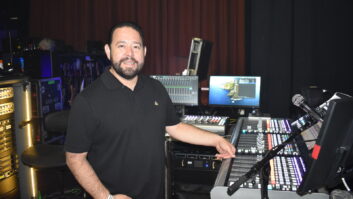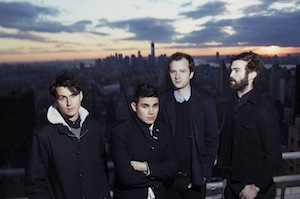
Left to right: Ezra Keonig, Rostam Batmanglij, Chris Baio, Chris Tomson
Photo: Alex John Beck
Just three albums into what is already a hugely successful career, the New York indie band Vampire Weekend continue to surprise and confound expectations. Their latest album, Modern Vampires of the City (XL Recordings), is their most sonically adventurous work so far, at the same time it contains all the hallmarks of the band’s instantly recognizable sound—Ezra Koenig’s dynamic high lead vocals (and intelligent, quirky and sometimes opaque lyrics), the clever blending of lo-fi and hi-fi elements, and a sharp rhythmic attack that often combines unconventional textures in unusual ways. One never senses that they’re pandering to commercial tastes, yet their following has grown with each increasingly idiosyncratic album. They’re making up their own rules as they go along, and thriving.
According to Rostam Batmanglij, the group’s musical guiding light, producer and engineer, making the new album “came about somewhat differently than the first two. With Contra [the band’s 2010 sophomore opus], we had about half the songs that we could perform in some way, shape or form before we set out to record them. Then the other half of the songs was more constructed. With this record, there was a long, extended period of songwriting and trying different ways of writing. Ezra and I got together three or four times a week for about a year, and we also interspersed working in different configurations—such as getting together as a band, though we didn’t find that was very fruitful. The result was we used the recording process as a writing and arranging tool to a greater extent than we ever did before.”
Much of the early work on Modern Vampires of the City took place in multi-instrumentalist Batmanglij’s home studio, which has been evolving steadily through the years as he’s moved up the musical ladder. “The first multitrack recording system I had was a MiniDisc 4-track,” he says. “Then I graduated to a Boss 8-track that recorded onto zip disks. When I was 18, I bought an M-box, and those were great. I recorded a ton of stuff with that M-box that made it onto records.” These days he works in a Pro Tools environment and has amassed an impressive collection of both high-end outboard gear and the latest plug-ins.

Members of Vampire Weekend in the studio.
Photo by Lauren Dukoff
Some songs on the new album emerged from trial-and-error experimentation with beats, melodies and bass lines created on a broad array of synths and boxes. Others were more traditional: “Ezra and I took a writing trip to Martha’s Vineyard [in coastal Massachusetts] and worked together in a friend’s guest house there; really just a cottage. We’d never really done that before. We packed up our van, and I basically brought a guitar, a bass, a MIDI keyboard, and at the time I had a desktop computer that was devoted to recording, and I brought a microphone, and we spent four days with nothing but songwriting as a goal. Out of that came ‘Don’t Lie,’ ‘Everlasting Arms’ and we started ‘Hudson.’ The acoustic guitar in ‘Don’t Lie’ was recorded in that room, and we never changed it. And that was true of a lot of stuff we recorded in my apartment in New York, too—there’s a bunch of piano and other parts we recorded in my apartment that’s on the album.”
For the first time, though, Batmanglij and Koenig also brought in a co-producer as a third set of ears and creative partner—L.A.-based Ariel Rechtshaid, whose diverse list of credits include Major Lazer, Usher, Plain White T’s (the smash “Hey Delilah”) and We Are Scientists. Rechtshaid says he and Batmanglij have been friends for a few years, “and when I had my band, Foreign Born, we had the same booking agent as Vampire Weekend, and Rostam and I met and slowly became friends. He was kind of the in-house producer in his band, and I played a similar role in my band, and somehow that came together. It was all just timing—this is the third [Vampire Weekend] record and I think maybe he just thought the time was right to get some help. The band was spending some time out in L.A. and Rostam had worked with me at my studio a couple of times, and he asked if he and Ezra could come over and work on some stuff.”
Batmanglij adds, “When Ezra and I got to L.A., we weren’t totally sure if we’d written all the songs for the record, but it became apparent that we hadn’t. So we started opening up the sessions with Ariel, and then the process of continuing work on the sessions was totally seamless because Ariel and I had the same Pro Tools setup, and over the course of working on the record, we made our setups identical so we could open up any session on each other’s computers—that was crucial to the process.”

Vampire Weekend in Studio A.
Photo by Lauren Dukoff
Rechtshaid actually has two studios—the Echo Park Back House (as it’s called in the VW album credits) and Slow Death in Burbank. “We kind of bounced around between the two places,” Rechtshaid says, “and I heard songs and listened to stuff, gave some opinions, tried some things. By the end of the week, it was evident we had a good chemistry. In fact, we managed to break through a couple of hurdles they’d come upon. They’re very capable of writing songs and recording themselves, but there are sometimes points where you lose perspective and just don’t know what direction to take it. That was my initial involvement, and on certain songs that’s all it was. But on other songs it was more instrumental.
“We did a lot of experimenting and trying things different ways,” Rechtshaid continues. “All three of us had a strong hand in the final product. Ezra had a lot to say about how his vocals sounded, and other ideas, too. There isn’t really a demo process in this band, because if you’re recording something at any stage in any place, it could be part of the final product. Fly it around, time-stretch it, pitch it up, slow it down, chop it up. It used to be that recording audio into a computer was to be able to manipulate it to fix performances, but in this case it’s more to create a new sonic thing with loads of different sources, rather than making up for some lack of ability.
“With the song ‘Step,’ for example, we recorded it in a few different keys in the so-called ‘demo’ process,” Rechtshain says. “We finally agreed on a key, and the way we agreed on it was by pitch-shifting the original demo a few different times, trying to sing different parts, and then when we went to do final vocals, we didn’t like it as much. It turns out we liked the vocal recorded a half-step lower and pitched up, so that’s what we did. We took parts of it from the original demo and also went back and recorded it in a different key and pitched it back up—not because Ezra couldn’t hit the high notes, but because it sounded more interesting and weird. Still, it’s not pitched up so you’d notice.”

Vampire Weekend in Studio B.
Photo by Lauren Dukoff
In the demented rockabilly-surf-punk tune “Diane Young,” the pitch-shifting on parts of Koenig’s heavily reverb’d lead vocal is almost cartoonishly radical. “That’s something we did in L.A.,” Batmanglij says. “Me and Ezra and Ariel were sitting in a room together and talking about that section of the song, and we thought it was too plain. At one point we pitched down the whole vocal in that section an octave, and there was something we liked about that—it sounded fresh in a way, but it also maybe sounded a little too extreme. But ultimately we found a middle ground using a formant shifting. A few months ago, I discovered the formant shift in Antares Auto-Tune and I showed it to Ariel, and it was one of those things where you learn about something for the first time and you get excited and you want to use it. It was his idea to automate it so it was moving in a smooth way up and down. It was definitely the product of the three of us sitting in a room and banging our heads together, trying to come up with an original way to present that part of the song.”
Most of the vocals on the album were recorded with a Soundelux U99 microphone going into a Neve preamp and a vintage 1176. Still, Batmanglij notes, “there’s UAD [plug-ins] all over this record. If you’re running the vocals through a real 1176 once and then you do it again with emulation, it just sounds better.”
Rechtshaid is also a fan of plug-ins: “I’ve pretty much bought everything UAD has built. I have an EMT 140 tube stereo plate, but I find myself often going to the plug-in because I like the way it sounds.” Other reverb and ambience tools used on Modern Vampires of the City included “a lot of AMS RMX-16—we used the real one as well as the Altiverb emulation, and matched up with the Eventide 910 and 949 [Harmonizers] we were using on the record for other pitch-shifted things.”

Throughout the album, there are passages that combine distorted/muffled instrumental parts with pristine ones, “which has always been part of our aesthetic as a band, and that was something Ariel got right away,” Batmanglij comments. “It’s been an aspect of the band to use recordings that are made in different places and have different fidelity and to bring all those together. I’ve always thought that was a more interesting aesthetic than something that sounds like everything was recorded with the exact same microphone in the exact same room.”
The other two members of Vampire Weekend—bassist Chris Baio and drummer Chris Tomson—got more involved once the songs became more solidified. “On this record,” Batmanglij notes, “it was like there was a sketch of almost every element inside of the session before we recorded the real version for the drum and bass. Still, there was definitely a freedom for improvising and for Chris and Chris to contribute to the arrangements of the songs. We had decided we wanted to record the drums to tape, so that was a big goal—to get the songs to a place where we could record all the drums.”
Most of Tomson’s and Baio’s parts were cut at L.A.’s Vox Studios, which Batmanglij describes as “one of the oldest studios in L.A., built in the 1930s. It’s kind of a secret spot tucked away behind a liquor store. We tracked drums for most of the songs [with engineer Dave Schiffman] in about two days. It’s a great-sounding old room with linoleum floors, and they had a wonderful collection of microphones. They also have a great old tape machine [a one-inch Ampex 300 8-track], and we really pushed the sound of the tape to the max.”
Rechtshaid adds, “[Baio and Tomson] are incredible musicians, and they took the template of what we had done and the structure and arrangement ideas we had and turned it into something that was more Vampire Weekend. A lot of the stuff we had was very programmed-sounding, and then when we went into a studio and tracked it for performance, it loosened up.” The drum miking setup was stripped down, with sometimes just three mics going straight to tape: “The fewer mics, the fatter the sound,” he says.
Rather than having a dedicated mixing period, Rechtshaid says, “we were mixing as we went along. The lovely folks at Avid supplied Rostam and me with their new HD Native Thunderbolt box. Rostam and I are on the left side of Pro Tools users—a lot of what we’re doing is in the box, and it’s not just a computer-based tape machine. It’s a complete production station where we’re really shaping sounds and using plug-ins to create the atmosphere and the vibe of the record. We’re always building as we go along, and eventually our rough mixes were our mixes. We took them over to Emily Lazar’s place [The Lodge] with the HD Thunderbolt and hooked up to her interfaces, and we were mastering and making adjustments to the mix as we were mastering.”
Lazar and Scott Jacoby mixed one song at Eusonia Studios in NYC, and super-mixer Rich Costey (Muse, The Shins, Foster the People, TV on the Radio, among others) mixed three tunes at Eldorado Studios in L.A. on an SSL 4000E. Batmanglij and Rechtshaid also did some of their work at Downtown Studios in New York, spreading out tracks from his laptop across their API console via the Thunderbolt box and an Avid DigiLink cable.
“The objective of this record was ‘fresh and new, or die!’” Rechtshaid laughs. “They’re not a band that has ever worried about the conventional single or radio, yet everything they’ve done has instinctually worked.”
ONLINE EXTRA: MORE FROM BATMANGLIJ AND RECHTSHAID
On the working relationship of Batmanglij, Reictshaid and Koenig.
Batmanglij: “Ariel and I had worked on music together and we’re really close friends. It was a friendship thing. We’ve also spent a lot of time just hanging out. On this record it was such an extended period of songwriting and we were working in different ways, and one thing that was unique about it is, there were a lot of songs I started on my own and I would start with writing music and even production ideas and sending them to Ezra, and he would write on top of them. There’s always been a couple of songs that have been that way, but on this record it really became a huge part of the writing process. So it was nice to have another voice in there.”
On the song “Obvious Bicycle.”
Batmanglij: “That song started with a piece of music I made that has these very, very hectic drums; they were super-complicated intricate polyrhythmic drums and piano. I sent it to Ezra—actually it was something I sent to Ezra before we finished Contra, and then, over the course of the Contra tour, he was writing on top of that music, and it was one of the first things we got together and worked on when we started working on this new album.
“We kept refining it, we added a bridge. I came up with a counter-melody for the chorus, but we also knew it wasn’t quite right. Something about it wasn’t really gelling. Eventually what we found was we didn’t need the hectic drums anymore, so we brought in a sample from a Jamaican nyabinghi [drum], so that’s what you’re hearing there. It’s the only recording sample on the record. At one point, we were really frustrated and Ariel said, ‘Listen, if you guys believe in the song, why don’t you perform it live [as a duo] and see what happens?’ We didn’t end up using that recording, but it showed us we should pursue a minimalist path for the songs and let it breathe.”
On writing “Diane Young.”
Batmanglij: “That started with the idea of a punk song with saxophone. As for the crazy drums, I was working on it and not really thinking about the decisions I was making—I was cutting up 16th notes and copying them and pasting them at random and not really thinking twice about it. I didn’t even think it would be part of Vampire Weekend, to be honest. But then I sent it Ezra and he started writing on top of it and now, when we play it live, Chris [Tomson] uses a sample pad in conjunction with his drum set, and he triggers some of the samples in the song, but we’re not playing to a click. So, some of those hectic moments are being triggered.”
Rechtshaid: “Some of the drums you call ‘impossible’ shockingly are a real human being, and some of the simple stuff isn’t. Rostam has a good friend in New York, Jeff Curtin, who did some recording and got these crazy, distorted drum fills and loops and stuff happening that was sort of to a tempo—or had a tempo to it. And then there was this song that was kind of like a basic rockabilly song with an emphasis on lyrics. Then, from that point, it was putting different things together and playing around, and anytime something sounded good that was great.
“Step one would be completing a structure of a song. Step two would be fooling around with an arrangement. Step three was getting it to sound like something, and step four was assessing whether that something was familiar, in which case throw it away and start over.”
Batmanglij: “The reverb on the vocal was something we actually dialed down. From the very first take that was an element of the version we recorded in my apartment. Same with the saxophone, which is real saxophone, but it’s been pitch-shifted because we were trying to fit it in the best part of Ezra’s vocal range. But the original beat that I sent him already had the drums sketched in place, and the saxophone I recorded in my apartment.”
On the strings and horns that appear here and there.
Batmanglij: “It’s a combination of real string players and Chamberlain strings. Like on ‘Everlasting Arms,’ I was very keen to have real string players, but Ezra and Ariel thought it was not necessary. They were right—it sounded better with chamberlain strings. But on others there are real strings. On ‘Don’t Lie,’ my string arrangement required about three different separate passes by the quartet because there were so many notes. We recorded the strings and horns at Vox [in L.A.].


